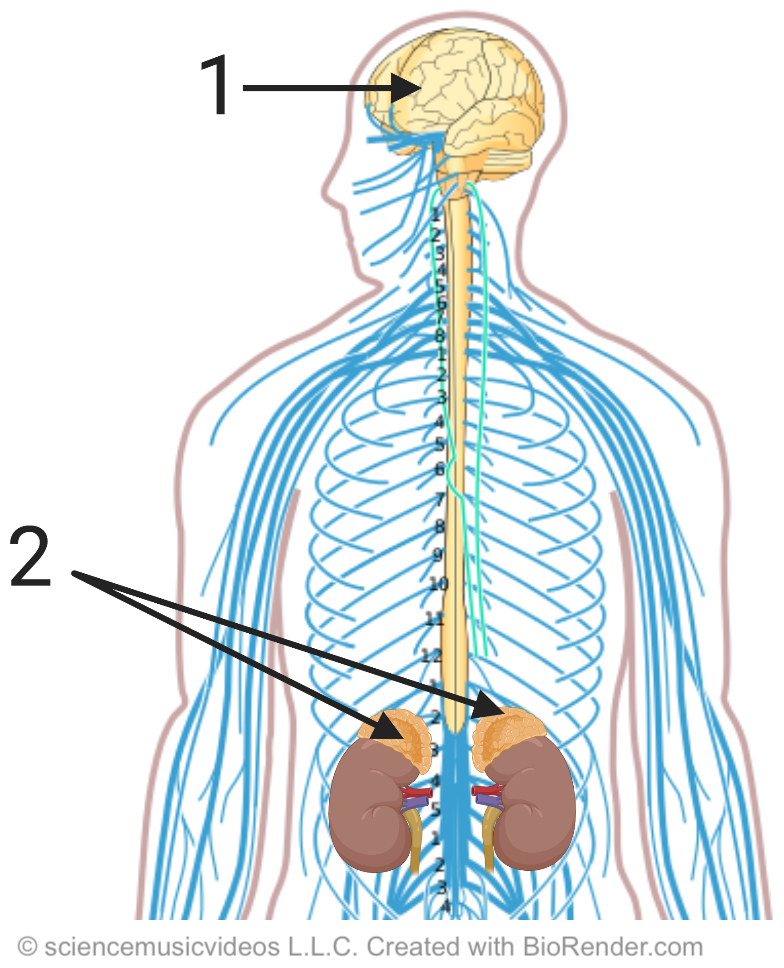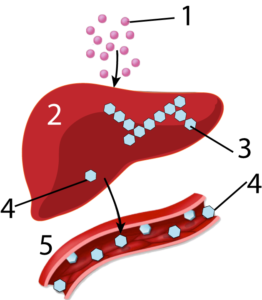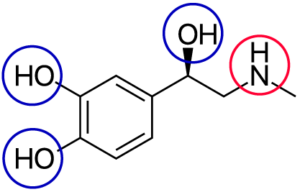1. Introduction: Energy for Fight or Flight
 We’ve all had the experience of being scared.
We’ve all had the experience of being scared.
It might not be as scary as what’s shown on the right, but you know the effects. Your pulse quickens. Your face feels flushed. Your hair stands up on end. Your pupils dilate. It’s called the fight or flight response.
 The fight or flight response is the result of nerve impulses and chemical signals that are coursing throughout your body. The adrenal glands (at “2”), responding to a nerve impulse from the brain (at “1”), release a hormone called epinephrine (also known as “adrenaline”). Epinephrine enters your bloodstream and has a variety of effects on targeted tissues throughout the body.
The fight or flight response is the result of nerve impulses and chemical signals that are coursing throughout your body. The adrenal glands (at “2”), responding to a nerve impulse from the brain (at “1”), release a hormone called epinephrine (also known as “adrenaline”). Epinephrine enters your bloodstream and has a variety of effects on targeted tissues throughout the body.
Epinephrine is a well-known hormone because it’s the substance that’s loaded inside an EpiPen: an easy-to-use epinephrine injection device that can be used to counteract a severe allergic reaction known as anaphylaxis. Anaphylaxis can be triggered by bee stings, foods, or other substances. Symptoms of anaphylaxis can be life-threatening and include hives, swelling of the tongue, asthma, shortness of breath, a weak pulse, dizziness, and shock.
Epinephrine counteracts almost all of these symptoms, and a quick injection can be the difference between life and death.

Another target of epinephrine (represented by “1,” on the right) is the liver (“2”). Among the liver’s many functions is to store food energy in the form of glycogen (“3”). Glycogen is a polysaccharide that’s composed of glucose monomers chained together. When the body needs a quick shot of glucose to power the contractions of skeletal and heart muscle, the glycogen in the liver can be reconverted into glucose (“4”). At the bottom of the diagram, you can see glucose diffusing into the bloodstream (“5”), where it will circulate to the muscles. (Note: click here for a review of polysaccharides and monosaccharides.)
To be able to quickly convert glycogen into glucose, your liver cells contain a team of enzymes that are synthesized in an inactive form. There they wait until they receive a command, in form of epinephrine, that says: “The body needs glucose. Break that glycogen down now!” So, the question that will guide us as we move forward is how do the cells that respond to epinephrine turn those enzymes on? Epinephrine, like all hormones, is a signal. How does this signal work?
The music video below gives you an overview of the answer. Based on how you like to learn, you might want to view it now, or come back to it after you’ve completed the next few tutorials.
2. Cell Signaling: An Overview
Above, I referred to epinephrine as a hormone. A hormone is a substance that is produced in a gland in one part of the body, diffuses into the bloodstream, and then has an effect on targeted tissues elsewhere in the body.
Before we see how epinephrine works, let’s take a look at it.

Notice that epinephrine consists of a central carbon ring, with a short hydrocarbon tail attached to it. Connected to the ring itself are two hydroxyl groups (indicated by blue circles). Connected to the hydrocarbon tail is another hydroxyl group and an amine group (circled in red). What’s important is that the hydroxyl groups and the amine group are polar, which means epinephrine won’t diffuse through the phospholipid bilayer of the cells it comes into contact with.
If epinephrine can’t enter a cell, how can it change the cell’s internal activities? A general scheme for how cell signaling works involves three steps, as shown in the diagram below.
- Step I is reception. A signaling molecule such as epinephrine (represented by “1”), binds with a membrane receptor (“2”). Note that
 in this diagram “a” represents the extracellular fluid (the fluid outside the cell), “b” represents the cell membrane, and “c” represents the cytoplasm.
in this diagram “a” represents the extracellular fluid (the fluid outside the cell), “b” represents the cell membrane, and “c” represents the cytoplasm.
The signaling molecule, as we discussed in the previous tutorial, is a ligand: a molecule that binds with another molecule. In this case, the ligand is a hormone (a ligand that’s produced in a gland and which circulates in the bloodstream). - Step II is transduction. Transduction is the “process of converting … a message into another form” (Merriam-Webster Medical Dictionary). In this case, the original message is the epinephrine that was released from the adrenal glands. After epinephrine binds with the membrane receptor, the cell releases one or more molecules, shown at “3a,” “3b,” and “3c,” that relay the initial message throughout the cytoplasm. As we’ll see below, one advantage of such a relay system is that it allows for the initial signal to be amplified, allowing for a quick and vigorous cellular response. “Quick” and “vigorous,” of course, are what you need if you’re in flight-or-flight mode.
- Step III is the response. Often this response involves changing an inactive form of an enzyme into its active form. In the case of epinephrine and liver tissue, we’ll see how the response involves the activation of a team of inactivated enzymes that stand poised to break glycogen down into glucose, releasing glucose into the bloodstream.
In what follows, we’ll go into the details of all three of these phases. But now, consolidate your learning with a quiz.
3. Quiz: Introduction to Cell Signaling and Epinephrine Action
[qwiz random=”true” qrecord_id=”sciencemusicvideosMeister1961-cell signaling and epinephrine action (v2.0)”]
[h]Cell Signaling and Epinephrine Action
[i]
[q dataset_id=”SMV_Cell Signalling and Epinephrine action (cell communication)|64009fd682fff” question_number=”1″] Which number could be a hormone?
[textentry single_char=”true”]
[c]ID E=[Qq]
[f]IFllcy4g4oCcMeKAnSBpcyB0aGUgc2lnbmFsLCBhbmQgaG9ybW9uZXMgYXJlIGxvbmctZGlzdGFuY2Ugc2lnbmFsaW5nIG1vbGVjdWxlcy4=[Qq]
[c]ICo=[Qq]
[f]IE5vLiBIZXJlJiM4MjE3O3MgYSBoaW50LiBIb3Jtb25lcyBhcmUgbG9uZy1kaXN0YW5jZSBzaWduYWxpbmcgbW9sZWN1bGVzLCBzZWNyZXRlZCBpbnRvIHRoZSBibG9vZCBhbmQgcmVjZWl2ZWQgYXQgb3RoZXIgcGFydHMgb2YgdGhlIGJvZHkuIFdoaWNoIG51bWJlciBjb3VsZCBiZSB0aGUgc2lnbmFsPw==
Cg==[Qq]
[q dataset_id=”SMV_Cell Signalling and Epinephrine action (cell communication)|63fb62bbc1fff” question_number=”2″] Which number could be the receptor?
[textentry single_char=”true”]
[c]ID I=[Qq]
[f]IFllcy4g4oCcMuKAnSBpcyB0aGUgcmVjZXB0b3Iu[Qq]
[c]ICo=[Qq]
[f]IE5vLiBIZXJlJiM4MjE3O3MgYSBoaW50LiBJbiB0aGlzIGRpYWdyYW0sIHdoaWNoIG1vbGVjdWxlIGlzIHJlY2VpdmluZyBhIHNpZ25hbCBmcm9tIG91dHNpZGUgdGhlIGNlbGw/
Cg==[Qq]
[c]IEVudGVyIGxldHRlcg==[Qq]
[f]IE5vLCB0aGF0JiM4MjE3O3Mgbm90IGNvcnJlY3Qu[Qq]
[q dataset_id=”SMV_Cell Signalling and Epinephrine action (cell communication)|63f5db1f847ff” question_number=”3″] Which number or letter represents the cell membrane?
[textentry single_char=”true”]
[c]IG I=[Qq]
[f]IFllcy4g4oCcYuKAnSBpcyB0aGUgY2VsbCBtZW1icmFuZS4=[Qq]
[c]ICo=[Qq]
[f]IE5vLiBIZXJlJiM4MjE3O3MgYSBoaW50LiBJZiAmIzgyMjA7YyYjODIyMTsgaXMgdGhlIGN5dG9wbGFzbSwgd2hhdCB3b3VsZCBoYXZlIHRvIGJlIHRoZSBjZWxsIG1lbWJyYW5lPw==
Cg==[Qq]
[q multiple_choice=”true” dataset_id=”SMV_Cell Signalling and Epinephrine action (cell communication)|63f09e04c37ff” question_number=”4″] Which roman numeral represents reception?
[c]IE k=[Qq]
[c]IElJ[Qq]
[c]IElJSQ==[Qq]
[f]IFllcy4g4oCcSeKAnSByZXByZXNlbnRzIHJlY2VwdGlvbi4=
[f]IE5vLiBJSSByZXByZXNlbnRzIA==dHJhbnNkdWN0aW9uLiBXaGVyZSwgaW4gdGhpcyBkaWFncmFtLCBkbyB5b3Ugc2VlIGEgc2lnbmFsIGJlaW5nIHJlY2VpdmVkPw==[Qq]
[f]IE5vLiBJSUkgcmVwcmVzZW50cyB0aGUgY2VsbHVsYXIgcmVzcG9uc2U=LiBXaGVyZSwgaW4gdGhpcyBkaWFncmFtLCBkbyB5b3Ugc2VlIGEgc2lnbmFsIGJlaW5nIHJlY2VpdmVkPyA=
Cg==[Qq]
[q multiple_choice=”true” dataset_id=”SMV_Cell Signalling and Epinephrine action (cell communication)|63eb166885fff” question_number=”5″] Which roman numeral represents transduction?
[c]IEk=[Qq]
[c]IE lJ[Qq]
[c]IElJSQ==[Qq]
[f]IE5vLiDigJxJ4oCdIHJlcHJlc2VudHMgcmVjZXB0aW9uLiBXaGVyZSwgaW4gdGhpcyBkaWFncmFtLCBkbyB5b3Ugc2VlIGEgc2lnbmFsIGJlaW5nIHJlbGF5ZWQgYmV0d2VlbiB3aGVyZSBpdCYjODIxNztzIGJlaW5nIHJlY2VpdmVkIGFuZCB3aGVyZSBpdCYjODIxNztzIGJlaW5nIGNvbnZlcnRlZCBpbnRvIGEgY2VsbHVsYXIgcmVzcG9uc2UgKGF0IElJSSk=
[f]IFllcy4gSUkgcmVwcmVzZW50cyA=dHJhbnNkdWN0aW9uLg==[Qq]
[f]IE5vLiBJSUkgcmVwcmVzZW50cyB0aGUgY2VsbHVsYXIgcmVzcG9uc2U=LiBXaGVyZSwgaW4gdGhpcyBkaWFncmFtLCBkbyB5b3Ugc2VlIGEgc2lnbmFsIGJlaW5nIHJlbGF5ZWQgYmV0d2VlbiB3aGVyZSBpdCYjODIxNztzIGJlaW5nIHJlY2VpdmVkIGFuZCB3aGVyZSBpdCYjODIxNztzIGJlaW5nIGNvbnZlcnRlZCBpbnRvIGEgY2VsbHVsYXIgcmVzcG9uc2UgKGhlcmUgYXQgSUlJKQ==
Cg==[Qq]
[q multiple_choice=”true” dataset_id=”SMV_Cell Signalling and Epinephrine action (cell communication)|63e58ecc487ff” question_number=”6″] Which roman numeral represents cellular response?
[c]IEk=[Qq]
[c]IElJ[Qq]
[c]IElJ SQ==[Qq]
[f]IE5vLiDigJxJ4oCdIHJlcHJlc2VudHMgcmVjZXB0aW9uLg==
[f]IE5vLiBJSSByZXByZXNlbnRzIA==dHJhbnNkdWN0aW9uLg==[Qq]
[f]IFllcy4gSUlJIHJlcHJlc2VudHMgdGhlIA==Y2VsbHVsYXIgcmVzcG9uc2U=Lg==
Cg==[Qq]
[q dataset_id=”SMV_Cell Signalling and Epinephrine action (cell communication)|63dfbcae8e7ff” question_number=”7″] Which number represents a ligand?
[textentry single_char=”true”]
[c]ID E=[Qq]
[f]IFllcy4g4oCcMeKAnSBpcyB0aGUgc2lnbmFsLiBTaWduYWxzIHdvcmsgYmVjYXVzZSB0aGV5JiM4MjE3O3JlIGxpZ2FuZHM6IHRoZXkgYmluZCB3aXRoIGEgcmVjZXB0b3Iu[Qq]
[c]ICo=[Qq]
[f]IE5vLiBIZXJlJiM4MjE3O3MgYSBoaW50LiBBIGxpZ2FuZCBiaW5kcyB3aXRoIGEgcmVjZXB0b3IuIFdoaWNoIHBhcnQgaXMgc29tZXRoaW5nIHRoYXQmIzgyMTc7cyBiaW5kaW5nIHdpdGggYSByZWNlcHRvcj8=[Qq]
[c]IEVudGVyIGxldHRlcg==[Qq]
[f]IE5vLg==[Qq]
[q dataset_id=”SMV_Cell Signalling and Epinephrine action (cell communication)|63da351250fff” question_number=”8″] Which number represents epinephrine?
[textentry single_char=”true”]
[c]ID E=[Qq]
[f]IFllcy4g4oCcMeKAnSByZXByZXNlbnRzIGVwaW5lcGhyaW5lLg==[Qq]
[c]ICo=[Qq]
[f]IE5vLiBIZXJlJiM4MjE3O3MgYSBoaW50LiBFcGluZXBocmluZSBpcyBwcm9kdWNlZCBpbiB0aGUgYWRyZW5hbCBnbGFuZHMgYW5kIHRoZW4gY2lyY3VsYXRlcyB0aHJvdWdob3V0IHRoZSBib2R5IGluIHRoZSBibG9vZCwgYWZmZWN0aW5nIHRhcmdldCBjZWxscyBpbiBtYW55IHRpc3N1ZXMsIGluY2x1ZGluZyB0aGUgbGl2ZXIuIFdoaWNoIG51bWJlciBzaG93cyBzb21ldGhpbmcgb3V0c2lkZSB0aGUgbGl2ZXIgdGhhdCBjb3VsZCBjYXVzZSBhIGNoYW5nZSBpbnNpZGUgdGhlIGxpdmVyLg==[Qq]
[c]IEVudGVyIGxldHRlcg==[Qq]
[f]IE5vLg==[Qq]
[q dataset_id=”SMV_Cell Signalling and Epinephrine action (cell communication)|63d35e2f633ff” question_number=”9″] Which number represents glycogen, the polysaccharide that gets broken down to glucose after the liver receives the epinephrine signal.
[textentry single_char=”true”]
[c]ID M=[Qq]
[f]IFllcy4g4oCcM+KAnSByZXByZXNlbnRzIGdseWNvZ2VuLg==[Qq]
[c]ICo=[Qq]
[f]IE5vLiBIZXJlJiM4MjE3O3MgYSBoaW50LiBHbHljb2dlbiBpcyBhIHBvbHlzYWNjaGFyaWRlLCB3aGljaCBtZWFucyB0aGF0IGl0JiM4MjE3O3MgY29tcG9zZWQgb2YgbWFueSBtb25vc2FjY2hhcmlkZSBzdWJ1bml0cy4gTG9vayBhdCB0aGUgbW9sZWN1bGUgc2hhcGVzIG9uIHRoZSBkaWFncmFtLCBhbmQgY2hvb3NlIHRoZSBvbmUgdGhhdCBsb29rcyBsaWtlIGl0JiM4MjE3O3MgbWFkZSBvZiBtYW55IHN1YnVuaXRzIHRoYXQgYXJlIGJvbmRlZCB0b2dldGhlci4=[Qq]
[c]IEVudGVyIGxldHRlcg==[Qq]
[f]IE5vLg==[Qq]
[q dataset_id=”SMV_Cell Signalling and Epinephrine action (cell communication)|63cdd69325bff” question_number=”10″] Which number represents glucose?
[textentry single_char=”true”]
[c]ID Q=[Qq]
[f]IFllcy4g4oCcNOKAnSByZXByZXNlbnRzIGdsdWNvc2Uu[Qq]
[c]ICo=[Qq]
[f]IE5vLiBIZXJlJiM4MjE3O3MgYSBoaW50LiBHbHVjb3NlIGlzIGEgbW9ub3NhY2NoYXJpZGUgKGEgc2ltcGxlIHN1Z2FyKS4gR2x5Y29nZW4gaXMgYSBwb2x5c2FjY2hhcmlkZSwgd2hpY2ggaXMgY29tcG9zZWQgb2YgbWFueSBnbHVjb3NlIHN1YnVuaXRzLiBMb29rIGF0IHRoZSBtb2xlY3VsZSBzaGFwZXMgb24gdGhlIGRpYWdyYW0sIGFuZCBjaG9vc2UgdGhlIG9uZSB0aGF0IGxvb2tzIGxpa2UgaXQmIzgyMTc7cyBtYWRlIG9mIA==b25lIHN1YnVuaXQsIGFzIG9wcG9zZWQgdG8gbWFueQ==IHN1YnVuaXRzIHRoYXQgYXJlIGJvbmRlZCB0b2dldGhlci4=[Qq]
[c]IEVudGVyIGxldHRlcg==[Qq]
[f]IE5vLg==[Qq]
[q dataset_id=”SMV_Cell Signalling and Epinephrine action (cell communication)|63c8997864bff” question_number=”11″] A molecule that binds with a receptor (such as “1” below) is most generally known as a
[hangman]
[c]IGxpZ2FuZA==[Qq]
[f]IENvcnJlY3Qh[Qq]
[q dataset_id=”SMV_Cell Signalling and Epinephrine action (cell communication)|63c2ec9b68fff” question_number=”12″] Number 2 below is a
[hangman]
[c]IHJlY2VwdG9y[Qq]
[f]IENvcnJlY3Qh[Qq]
[q dataset_id=”SMV_Cell Signalling and Epinephrine action (cell communication)|63bd64ff2b7ff” question_number=”13″] The process indicated by roman number II below is called signal
[hangman]
[c]IHRyYW5zZHVjdGlvbg==[Qq]
[f]IENvcnJlY3Qh[Qq]
[x]
[restart]
[/qwiz]
What’s next?
- Proceed to Topics 4.2 – 4.3, Part 2: Reception (the next tutorial in AP Bio Unit 4)
